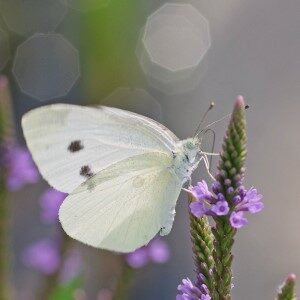Note: All links below go to external sites.
Howdy, BugFans,
As temperatures (slowly) begin to get milder, butterflies are making an appearance. What a treat to see an Eastern Comma basking like a small flame in the sunlight along a trail, or the shadow of a butterfly crossing the path! The butterflies of early spring are Compton Tortoiseshells, Anglewings (mostly Eastern Commas), and Mourning Cloaks that have spent the winter as adults, pumping, not iron, but antifreeze. Along with the Spring Azures and Eastern Tailed-Blues, the next butterflies to appear should be the Cabbage Whites and, close on their heels, the Sulphurs. In their honor, the BugLady is dusting off this episode from the spring of 2010 and adding some new words and new pictures.
Cabbage/Cabbage Whites and the closely-related Sulphur/Alfalfa butterflies are among the first butterflies to appear that have actually emerged from a chrysalis in the current year. Both are in the family Pieridae, the Whites and Sulphurs. These are medium-sized (2” wingspan) butterflies; Cabbage butterflies are white and Sulphurs are yellow – except when they’re not. Read on.
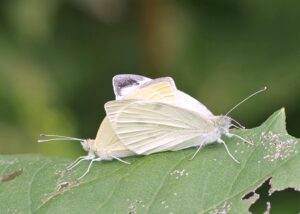
The CABBAGE WHITE BUTTERFLY (Pieris rapae) (the rapae part comes from its larva’s fondness for plants in the mustard/cabbage family) is actually a Eurasian butterfly that drifted south after its accidental introduction to Montreal about 150 years ago. It is also established in Hawai’i (1898), North Africa, New Zealand (1929) and Australia (1943). Like other introduced species, it liked what it saw; many of its favorite foodstuffs were agricultural crops that had also leapt the Pond – and it liked what it didn’t see, its native predators. Its caterpillar became a serious crop pest and was, for years, known as the “Imported Cabbageworm” (the BugLady once heard that the annual, per capita consumption of cabbage is 10 pounds, and she thanks all the folks – and the caterpillars – who have been doing the heavy lifting for her).
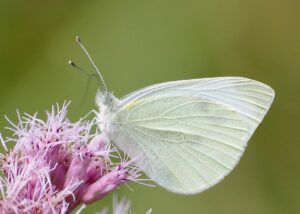
Depending on how they hold their wings when they perch, the butterflies’ underwings may look plain below or may show a spot (male) or two (female). The tips of their upper wings are edged in gray or black https://bugguide.net/node/view/1887566/bgimage.
Eggs are laid on the undersides of leaves of a host plant (she prefers to oviposit in sunny weather), and there the caterpillars stay. Though they do attack native mustards, they especially like cabbage, broccoli, and cauliflower leaves. If a hole appears in a cabbage leaf, flip the leaf over and check for the hole-maker. Adults nectar on a variety of flowers, preferring purple, blue, and yellow ones.
Cabbage Whites are hardy and they live fast, going from egg to adult in little more than a month. Several succeeding generations keep us in Cabbage Whites from early spring through the first hard freeze of fall, and the last generation overwinters in the pupa/chrysalis stage. They are suspected to have displaced a few native species of Whites.
In his excellent book Secret Weapons, chemical ecologist Thomas Eisner says that “Possession of defenses may in fact be one of the major determinants of a species’ ability to colonize new domains.” Cabbage White caterpillars have rows of glandular hairs on their backs and sides, and the oily liquid produced in the hairs is, at least, an effective ant-repellant. Birds that were given a tray holding variety of possible insect foods clearly ranked the acceptability of adult Cabbage Whites as “very low.” They might peck at a dead Cabbage White, but they seldom ate one, and the reason for this is not known.
People don’t like to buy produce riddled with wormholes and stained by frass (bug poop), and as the folks at the Oregon State University Department of Horticulture note, “consumers have a very low tolerance for worms in their frozen vegetables.” As a result, the species has been subjected to chemical and biological warfare in the form of pesticides, bacterial and viral infections, and by imported, alien parasitic wasps (some of these methods are indiscriminate about what they kill. Mother Nature doesn’t like “collateral damage”). In some cases (like DDT), the cure was worse than the disease, and yet, the Cabbage Whites keep coming.
They are strong fliers that are most active during mid-day (the BugLady found a single, tantalizing reference to their activity during the “graveyard” shift, the hours before dawn). You can find them in sunny agricultural fields, grasslands, gardens, and road edges in cities and suburbs and rural areas – in short, they are habitat generalists. There was a big alfalfa field across the road from the BugLady’s old house, and on some summer days when the alfalfa was in bloom, the air over the alfalfa flickered with hundreds of Cabbage Whites and Sulphurs.

CLOUDED AND ORANGE SULPHURS (Colias philodice and Colias eurytheme) are the most common Sulphurs in southeastern Wisconsin. They are very closely related, and, yes, they do hybridize (because a female may mate for the first time almost immediately after she emerges, before she learns to recognize her own species’ pheromones).
“Sulphur” refers to their color, not their smell. The upper sides of a Clouded Sulphur’s wings are (usually) yellow, and as you might expect, the upper sides of an Orange Sulphur’s wings are tinged with varying degrees of orange. A strongly-colored Orange Sulphur may also show an orange tinge on its underwings at rest. Sulphurs tend to fold their wings immediately after landing, so identification is best made when the butterfly is in flight or in-the-hand.
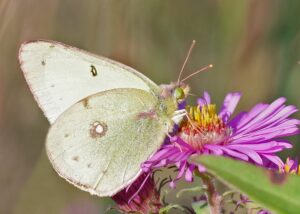 Populations of both Clouded and Orange Sulphurs produce some white females (called alba females), so beware – a white butterfly with black wing-tips is not always a cabbage butterfly! These alba females are larger than their yellow sisters, and they lay larger eggs, a reproductive adaptation to living here in the north country. Here’s an alba female Clouded Sulphur and an alba female Orange Sulphur. Note that they have a few small, ringed dots on the underside of both the front and hind wings.
Populations of both Clouded and Orange Sulphurs produce some white females (called alba females), so beware – a white butterfly with black wing-tips is not always a cabbage butterfly! These alba females are larger than their yellow sisters, and they lay larger eggs, a reproductive adaptation to living here in the north country. Here’s an alba female Clouded Sulphur and an alba female Orange Sulphur. Note that they have a few small, ringed dots on the underside of both the front and hind wings.
Where Cabbage White caterpillars favor mustards, the caterpillars of Clouded and Orange Sulphurs favor legumes (the bean/clover family). Like the Cabbage butterflies, adult Sulphurs are found in a variety of open habitats, where they nectar on flowers in the milkweed, composite/aster and bean families. Sulphurs famously gather at puddles in groups that sometimes number in the hundreds of butterflies – to sip the nutrients found in mud.
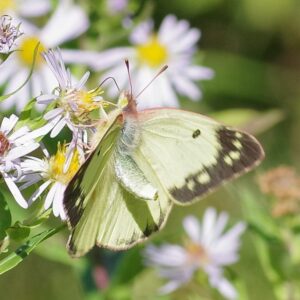
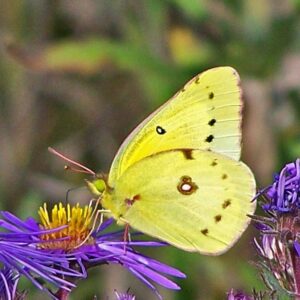

During courtship, male Orange Sulphurs recognize the appropriate female by the way UV light is absorbed by her hind wings, and she recognizes him by the way UV light is reflected by his wings (and by his pheromones). She lays eggs singly on the leaves of the host plant. Male Clouded Sulphurs hover over females, “buffeting” them with their wings and releasing pheromones – no UV light required. She lays eggs on any part of a host plant. An adult Clouded Sulphur’s lifespan is short – typically less than a week, but sometimes as long as three weeks. There are multiple generations per summer.
Check out A Guide to Observing Insect Lives, by Donald W. Stokes for a great description of spiral flights, an interesting and highly ritualized behavior that is shared by the Cabbage Whites and the Clouded and Orange Sulphurs. Spiral flights are “Bug off, Buster” flights initiated by females in response to unwanted attention from a male who has romance on his mind. Or by males responding to advances from nearsighted males that have made a gender misidentification (according to Stokes, it is believed that many butterflies cannot recognize even their own species until they are within about a foot of each other).
Both Sulphurs are found across the US and into Canada – Clouded Sulphurs are a bit sparse in the far South and West, and they occur as far north as Alaska, and Orange Sulphurs are uncommon in the Rockies and western Great Plains. According to Weber’s Butterflies of the North Woods, the Orange Sulphur is a southern butterfly that has extended its range dramatically in the past century (helped along by changing agricultural patterns). Of our two Sulphurs, the Orange Sulphur is less cold-tolerant (which is interesting because the BugLady typically sees more Orange Sulphurs at the end of the butterfly season and more Clouded Sulphurs at the start). They are often seen on the ground in fall, where they can bask in the sun, take advantage of the heat of the earth, and stay out of the wind.
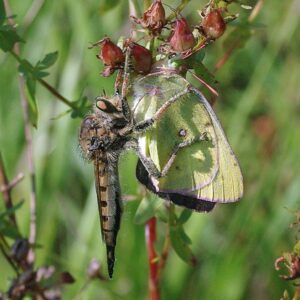
The BugLady highly recommends Butterflies of the Great Lakes Region (which does not include the Skippers) by Douglas and Douglas, and Weber’s Butterflies of the North Woods, which cover the Upper Great Lakes area, and Brock and Kaufman’s Field Guide to Butterflies of North America, a good field guide for the whole country. See Mike Reese’s excellent Butterfly site: http://wisconsinbutterflies.org/ for information about our butterflies, their flight periods and their distribution, along with dynamite pictures (check out the Robber flies and Tiger beetles while you’re there, too).
If it’s not tick season where you live, it will be very soon. For information about deer ticks, see here.
The BugLady
